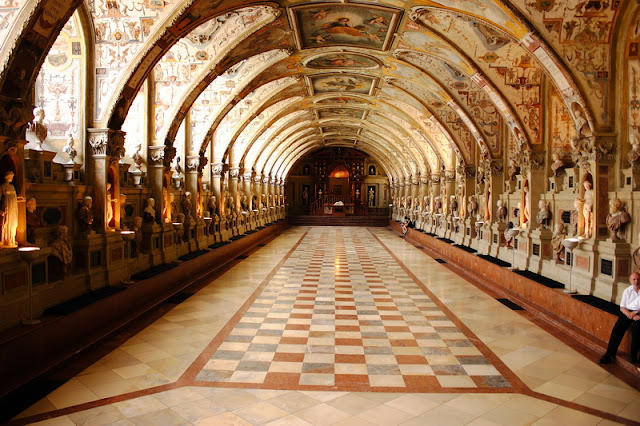Get your camera and train tickets, we’re heading out to see part of Munich.
Munich, like a formal meal, is large, and should be taken in single bites, rather than gulped down in a hurry. Therefore, we’re going to cover it that way, with today’s trip being to the Residenz. We’ll have a little time to hit the Hofbrauhaus, and wander through the gardens, but we’re going to get some exposure in the palace itself more than anything else.

ISO 100, f/4, 1/5
An Angel of the Tribulation, from the Antiquarium in Munich
From the Bahnhof, take the u-bahn to Odeonsplatz. From there, it’s a short walk through to the Residenz. Once you’re there, there are some nice cafés and places to grab a quick brunch and relax before beginning a tour through the palace.
Inside, you’ll be transported to another time. Wandering through this magnificent palace gives you a taste of how life was lived and how the royalty of the era enjoyed the excesses that were their privilege.
In the late 1300’s, the first palace or structure was built here. Later a new fortress was built here for the Wittlesbach dukes. As time progressed through several centuries, the site and building grew outward and incorporated tastes and styles of the time, including the Gothic base, and Renaissance, Baroque, and Rococo art and architecture.
The Antiquarium was built in 1571. It was basically a home for the antique collection and is the largest Renaissance hall north of the Alps. The court chapel and imperial hall, as well as several others, are common examples of the early 17th century. The baroque papal rooms and the ancestral gallery serve as good examples of the Rococo style.

ISO 100, f/3.5, 1/10
The Antiquarium in Munich Residenz. You can even sit here and read.
After the tour of the palace itself, there is the treasury. For anyone who loves artistic presentations and historical displays, this is the place! They have the crown of the Empress Cunigunde, as well as a reliquary of the cross, which belonged to Emperor Henry II. They also have a gold crown from 1370 that is the oldest surviving crown of England and the famous ruby decorated statue of St George slaying the dragon.

ISO 100, f/4.5, 1/8
The crown of the English Queen, from around 1370. It appears to be the dowry from the King of England on the marriage of his daughter.
The Hofgarten outside is incredible, especially in early summer. The gazebos and structures combine with walkways and flowers to make for a memorable sight. Bring a blanket and have a picnic. It’s a great way to spend the afternoon! Don’t forget to tip the buskers serenading you with their accordions and violins.
A couple of blocks away is the Hofbrauhaus, where you can get dinner and a nice beer before you catch the train home. Back to Odeonsplatz, then the bahnhof and we’re again on our way. Safely back home, we can view the magnificent shots we took and share them with those who weren’t fortunate enough to join our journey!
Throughout the tours are great opportunities for your camera to bring home memories, but don’t use your flash in the treasury or palace, it’s not allowed and you will be kicked out! Make sure to shoot manual, as you’re likely to get more winners that way.
Remember to get your vote in and to get started on your pics for this week’s theme, blurring the lines. A tip for this theme, when you’re creating your image, use blur to emphasize the way we as a society blur the lines in our day-to-day lives. It can create a real enhancement to your scene if used right!
Don’t forget to post any of your images you’d like to see here at the Hohenfels Volks Facebook page and to get your vote in for next week’s theme. Of course, commenting on both Facebook and here is always appreciated, too!










